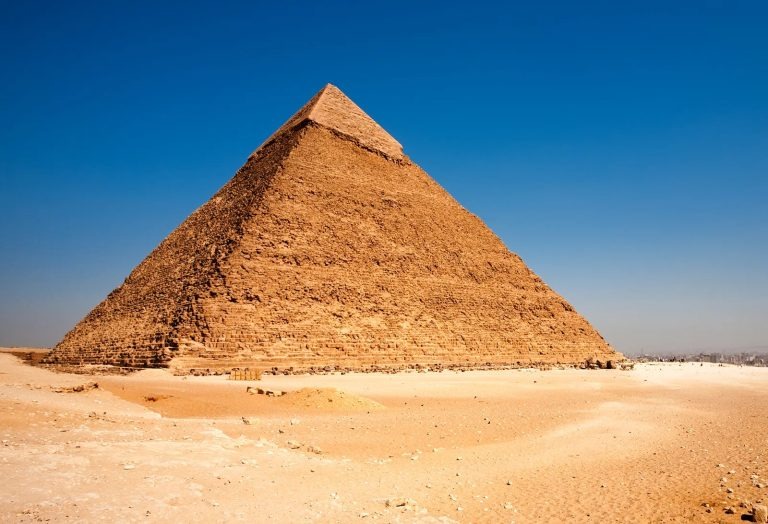The Giza Pyramids always seem to attract attention – not just from tourists, but from conspiracy theorists too. This week, the internet lit up with a new claim: Researchers supposedly found an underground city beneath the Pyramid of Khafre. Using radar tech, they say they uncovered tunnels, chambers, and even cube-shaped buildings hundreds of meters underground.
People were quick to jump on the story. Some said it was proof that ancient Egyptians had technology even more advanced than ours. Others claimed it was tied to lost civilizations or spiritual knowledge hidden from the public. Social media ran wild with it. But none of it adds up when you look closer.
The buzz started at a press conference in Bologna, Italy. Researchers showed off colorful charts and diagrams, claiming they had used something called Synthetic Aperture Radar (SAR) to map hidden structures beneath the Giza Pyramids. The drawings looked detailed and technical, giving the illusion of scientific proof.
That is a bold claim! If true, it would be massive news. But the truth is, none of it holds water.
SAR Doesn’t Work Like That
Experts immediately flagged this. Egypt’s Ministry of Tourism and Antiquities said no such scans were done. The tech described wouldn’t produce the kind of detailed maps the team showed. So how did they “see” a city that radar can’t possibly detect? Easy answer: They didn’t!
What Does the ‘Paper’ Behind the Claims Say?

The story goes back to a 2022 research paper published in Remote Sensing by Corrado Malanga and Filippo Biondi. They claimed to use radar to uncover hidden features inside the Great Pyramid. But no official excavation happened. No permits were granted. And no respected archeologist backed the claims.
The Egyptian government confirmed that no one used SAR equipment in or around the Giza Pyramids for this kind of project. That alone discredits the story. But it gets worse. The methods described are not accepted by the scientific community. The conclusions are based on shaky data at best or just pure imagination.
Others said it was proof of an ancient power plant, or even a spiritual “city of Amenti” tied to mystical energy and lost wisdom. These ideas aren’t new. They just got a fresh coat of paint.
None of these theories come with real evidence. No artifacts, excavation reports, or confirmations from scientists who specialize in ancient Egypt.
The Real Story of Who Built the Giza Pyramids
Archeologists found housing, tools, and food remains from worker villages near the pyramids. These workers were skilled, paid, and treated well. They worked in shifts and even had medical care. Some left graffiti on the walls, proudly naming their crews and bragging about their work. That is not how you treat slaves. It is how you manage professionals.
General Disclaimer: The information provided in this blog is for informational purposes only. Newlo Pedia makes no warranties regarding the accuracy or completeness of the content. Readers are advised to verify details independently before making decisions based on the information provided.
Content Disclaimer:This blog is intended to share general knowledge and insights. It is not meant to replace professional advice or guidance. Newlo Pedia does not endorse or guarantee the accuracy of any information presented here.
Advertising Disclaimer:This blog may include affiliate links or advertising content. Newlo Pedia may earn a commission from purchases made through these links, which helps support the platform. However, all opinions expressed are independent and based on our editorial standards.
Affiliate Disclosure:Some links in this blog may direct you to external websites, and Newlo Pedia may receive a commission for purchases made through these links. This does not influence the integrity or neutrality of the content provided.
Third-Party Links Disclaimer: This blog may contain links to third-party websites. Newlo Pedia does not assume responsibility for the accuracy, content, or policies of external websites. Readers are encouraged to review the terms and privacy policies of linked sites.
Legal Disclaimer: Newlo Pedia does not guarantee the safety, reliability, or quality of any products, services, or recommendations mentioned in this blog. Use any information or purchase products at your own discretion and risk.
Stock Image Disclaimer: Images featured in this blog are for illustrative purposes only. They may not reflect actual locations, products, or scenarios discussed in the content. These images are intended solely to enhance the reader’s experience.
Results Disclosure: The experiences or suggestions mentioned in this blog may vary from person to person. Outcomes are not guaranteed and depend on various factors, including individual preferences and circumstances.
Copyright Disclaimer: This content is the property of Newlo Pedia and is intended for personal use only. Redistribution or unauthorized use of this blog’s content is strictly prohibited.






